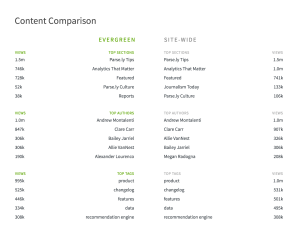3 Ways You Should Be Repurposing Content

The average piece of online content has a three-day lifespan. Evergreen content, on the other hand, broadly refers to any article, post, or video that garners significant attention well beyond this typical three-day cycle.
Evergreen articles are not tied to specific news events and don’t have an expiration date. For example, an article about the presidential election in Costa Rica likely won’t be evergreen, while a guide to visiting Costa Rica would be, because it stays relevant over time.
Consistent relevance, however, doesn’t mean evergreen content can’t or shouldn’t be updated and reused. Repurposing evergreen content can help you grow organic engagement and reach new audiences, without having to start from scratch. Here are three ways that brands can reuse evergreen content without reinventing the wheel.
- Update gems in your archives for new audiences
- Promote historically high-performing content during slow periods
- Create new visitor experiences by repurposing content
1. Update gems in your archives for new audiences
Take a look at the articles and posts that consistently perform well to determine what is repurpose-worthy. Search for content in your archives that gives context to current news events or highlights important historical anniversaries.
Use historical data from your analytics platform to find content that performed well, say, a year ago, to see if it’s still garnering attention from your audience. If you find consistently high-performing pieces, start by updating old information and republishing them for your readers.
Keep the following elements in mind when updating content:
- Usefulness (Is the content immediately actionable?)
- Clarity (Is the terminology outdated?)
- Tone (Does the writing match your current brand voice?)
- Shareability (Is the content relevant to today’s social media?)
While you shouldn’t have to do much to keep evergreen material up to date, there will be fresh reports, statistics, and articles that you can link to. Upgrading and republishing content might also help with SEO rankings. Once refreshed, promote your content as if it were a new piece.
Make sure readers can find historical articles by taking advantage of content tagging, using keywords, and other important distinguishers to make your archive more accessible. Smart Tags can also supplement your existing tags or do the work for you if you’re not tagging your content already.
2. Promote historically high-performing content during slow periods
Once you identify older content that’s still performing well based on your KPI thresholds, re-promote those pieces when your site is experiencing lower overall engagement. Push evergreen content on your social media and through email during content gaps in your calendar.
To re-promote your content effectively and engage new visitors, consider:
- Creating dedicated pages on your website that house evergreen content, like how-to guides and terminology articles.
- Making a “start here” page on your website that explains basic terminology or includes tutorial information.
- Creating a social media strategy centered on evergreen content that spans all of your social media platforms.
- Highlighting evergreen posts on your website’s homepage or in the blog’s sidebar.

Source: Hubspot
Ultimately, choose the methods that give your refreshed content the best chance to shine and succeed.
3. Create new visitor experiences by repurposing content
Use new channels to breathe life into evergreen content. Repackaging content in refreshed ways can lead to renewed interest and more visitors to your website.
A great example is the response of fan wiki platform Fandom.com to the release of the new Marvel movie Shang-Chi and the Legend of the Ten Rings. After noticing a significant pageviews spike to related wiki pages, Fandom.com created new social media content to capitalize on increased interest in the movie, with tweets getting thousands of likes.

Source: Fandom Twitter
The wiki also updated their pages to feature images of the actors, created native videos, and featured Shang-Chi content on their homepage.

Source: Fandom Twitter
All this new activity concerning content that had already been featured on their website was a no-brainer given the popularity of the topic. By recognizing new activity with content from their archive, Fandom.com created new pathways to explore it.
Here are more ways you can create new experiences with your content:
- Create ebooks out of a series of blog posts with similar topics. Sellbrite did this with their Sell Smarter e-books, which expand upon content from existing blog posts.
- Turn interviews or internal knowledge into podcasts like Vox does with Today, Explained. Here’s a great guide on how to repurpose content for audio formats.
- Take a page from the Fandom team’s book by repurposing content for social media. Create infographics in Canva or Photoshop.
- Use the email-to-blog pipeline and share short snippets of longer stories in newsletters like Morning Brew does.
Your content shouldn’t just be a mad dash for traffic and views. Whatever you create should ultimately provide new value to your audience and direct them to look for more great content on your website.
Start repurposing content with Parse.ly
With the sheer amount of content on the internet today, it‘s more important than ever for digital brands to be smart about repurposing content to make an impression on their audience. Even better, as you provide audiences with resonating content, you also reduce the pressure on content creators to perpetually be producing brand new content.
Pro tip: Use the Evergreen Overview Report to identify evergreen content and start repurposing it in Parse.ly. This feature identifies the stories that have kept users engaged long after you hit publish, emailing you an easy-to-scan, visual report.

Have any questions or want to try it for yourself? Get a Parse.ly demo today!